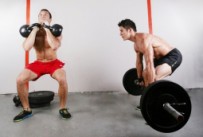Revisit the squat: correct foot position

Revisit the squat: correct foot position
Written by: Paul Kochoa, PT, DPT, OCS, CKTP, CGFI
In a previous post, I talked about the squat and how it’s a functional exercise and important for the whole body. Today, I’m going to zero in on where your feet should be when you squat.
During the squat, where do your feet point? In or out? Straight or crooked? True, the first thing you should think about if you read the other post is protecting the knee, and thinking about where your knees are pointing. Previously, I mentioned that they should be pointed in the same direction as the toes. But what direction is that?
If you look around at the gym at people squatting, you’ll probably see many variations of the squat and just as many opinions as to where the feet should be pointing and where you should put them. Ask five different personal trainers at five different gyms, and you may get just as many different answers. How about if I told you 3-7 degrees?
That’s 3-7 degrees of foot turn out, it winds up being just slightly off-center. Not a lot of foot turn out when you think about it, it’s almost straight ahead. But if you try your squat and vary the direction of the foot turn out, you’ll feel a difference in your stability, and your strength.
Now there are a lot of other factors that may limit this foot position for the squat, like primarily your hip rotation mobility or your ankle mobility, but this puts the whole lower body in a stronger, more stable position. First, you have to make sure you have sufficient hip and ankle mobility to get your feet in a good position. If you lack the mobility in those places, what generally happens is the foot gets pointed out too much, or the knees buckle inward when you squat, or both could happen which would be disastrous and may lead to knee ligament damage.
But if you have mobile hips and ankles, putting your feet shoulder-width apart, in 3-7 degrees of turn out puts you in an ideal position to generate force. With the feet stable, you can actively externally rotate the hips out during the squat (think of pushing your knees out), which keeps the knees from buckling in, protecting the knees, and creates this tension through the entire lower extremity via the fascia and allows the muscles to have a greater mechanical advantage. This leads to stronger, heavier lifts, and safer joints. Everybody’s happy.
If you’ve been keeping up with my posts, you’d be sensing a pattern here, just like the alternating pattern of stability and mobility in the body, and how it relates to functional movement. If you have any questions, feel free to fire away in the comments.
If you would like more information, please call Professional Physical Therapy and Training at 973-270-7417. Our offices are located within the YMCA locations in Madison and Summit, NJ. You do not need to be a member of the YMCA to visit with us.
Image courtesy of David Castillo Dominici / FreeDigitalPhotos.net